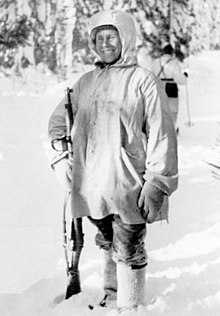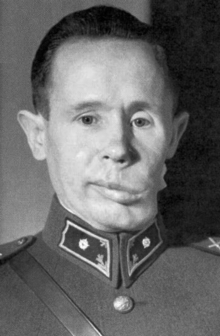Simo Häyhä
Simo Häyhä (born December 17, 1905 in Rautjärvi , † April 1, 2002 in Hamina ) was a Finnish soldier who served as a sniper in the Winter War (1939-1940) . The soldiers of the Red Army called Häyhä the "White Death" (Russian: Белая смерть, Belaja Smert ; Finnish: Valkoinen Kuolema; Swedish: Vita Döden). Mainly equipped with a Finnish version M / 28 of the Soviet Mosin-Nagant bolt action rifle , Häyhä killed more than 500 Soviet soldiers. Overall, the number of kills may exceed 700, making it the highest number of confirmed kills of a single sniper in any war.
Military service and service in the winter war
Häyhä was born in the Rautjärvi district near today's border between Finland and Russia. From 1925 he did his one-year military service and then worked as a farmer. During this time he also joined the Finnish National Guard ( Suojeluskunta ) before he was again a soldier in the winter war between Finland and the Soviet Union (1939/40).
After his draft, Häyhä was assigned to the infantry as a sniper and served in the 6th Company of Infantry Regiment (JR) 34. His unit fought in the Battle of Kollaa against parts of the 9th and 14th Soviet Armies. It is thanks to the fact that the Finns held this section of the front until the end of the Winter War that the soldiers deployed there are regarded as particularly heroic.
505 confirmed and 37 unconfirmed kills with his sniper rifle are attributed to Häyhä. The unofficial statistics from the front during the Battle of Kollaa even speak of over 800. In addition to the more than 500 soldiers killed with his sniper rifle, there are probably at least another 200 kills with a Suomi M-31 submachine gun . So Häyhä would have a total of over 700 kills. However, it is not entirely clear whether these 200 were not originally attributed to the presumably fictional Finnish war hero Sulo Kolkka (who was probably created by confusing foreign reporters with the journalist Sulo Kolkka and was probably based on Simo Häyhä). In view of the large number of his kills, it is noteworthy that he achieved them in just 100 days at the front, although the nights are still very long at this time of the year.
method
As a rifle, Häyhä used a Mosin-Nagant M / 28. It is a Finnish variant of an originally Russian rifle, which was called a pystykorva (German Spitz dog) due to the silhouette of the rear sight . He preferred the open sights instead of a telescopic sight for the following reasons :
- He wanted to make a smaller target because a sniper has to raise his head higher when using a telescopic sight.
- He wanted to prevent visibility problems, as the glass of a rifle scope can easily fog up.
- He wanted to hide his hiding place; Bright sunlight on the riflescope lens can reveal the position of the sniper.
To avoid being able to see his breath in the cold, Häyhä put a piece of snow in his mouth at a time.
In addition to his Mosin-Nagant rifle, he used the Suomi M-31 submachine gun as an additional weapon .
End of the war effort
On March 6, 1940, Häyhä was shot in the face by a Soviet sniper. The bullet penetrated the jaw, rotated, and left a severe head injury upon exit.
He is said to have regained consciousness on March 13, 1940, the day the peace treaty with the Soviet Union was signed. Shortly after the war, Häyhä was promoted directly to lieutenant by Commander-in-Chief Field Marshal Mannerheim from the rank of non-commissioned officer , a unique event in Finnish military history .
medal
- Finnish Order of the Cross of Freedom 1st, 2nd, 3rd and 4th class
Next life
It took Häyhä several years to recover from his serious injury. After the end of World War II, he became a successful moose hunter and dog breeder. In 1998, when asked, he stated that he had achieved his high precision "through practice". When asked whether he regretted killing so many people, he answered with "I did what I was told, as best I could".

Simo Häyhä spent the last years of his life in a small town called Ruokolahti , which is in southeastern Finland on the Russian border.
"The recoil !"
In popular culture
- In the television show Suuret suomalaiset ( The Greatest Finns ) on the Finnish national television YLE , Häyhä was named in 74th position.
- The Swedish band Sabaton released the album Coat of Arms in 2010, which includes the song "White Death" about Simo Häyhä.
literature
- P. Sarjanen, Valkoinen kuolema ISBN 952-5170-05-5
- Tapio AM Saarelainen, Sankarikorpraali Simo Häyhä ISBN 952-5026-52-3
- Tapio AM Saarelainen: The Sniper: Simo Häyhä . Apali, Tampere 2008, ISBN 978-952-5026-74-0 .
Web links
- Simo Häyhä: The White Death - World's Greatest Sniper . Mosin-Nagant.net, April 7, 2002 (English).
- Marc von Lüpke: Finnish sniper Simo Häyhä - The white death . one day on Spiegel Online, November 30, 2014.
- Tom Turula: The incredible life of Simo Häyhä, the world's deadliest sniper who killed hundreds during the Winter War . The European , March 13, 2017 (English).
- Gernot Kramper: The white death - how a Finnish farmer killed 505 Red Army soldiers . Stern.de , December 16, 2017.
- Florian Stark: He killed more than 500 people and was the terror of the Red Army. , World, March 9, 2020.
Individual evidence
- ^ The Sniper Log Book - World War II
- ^ Rayment, Sean: The long view . In: The Daily Telegraph , April 30, 2006. Retrieved March 30, 2009.
- ↑ Helsingin Reservin Sanomat 2006.
- ↑ a b Heiskanen / HS 2002.
- ^ Sean Rayment: The long view - Telegraph. In: telegraph.co.uk. April 30, 2006, accessed January 4, 2015 .
- ↑ a b Sotasankarit-äänestyksen voitti tarkka-ampuja Simo Häyhä. In: mtv3.fi uutiset. November 22, 2007, archived from the original on August 7, 2009 ; accessed on April 2, 2019 .
- ^ Film Fire and Ice: The Winter War of Finland and Russia
- ↑ Peter Brookesmith: Sniper, 2nd Edition. St. Martin's Press, 2007, ISBN 978-0-312-36290-4 , p. 37. Restricted preview in the Google book search
- ↑ Kansallisbiografia 2003. Lappalainen / HS 2001 yes Brandtberg kertovat luvuksi 542.
- ↑ Simo Häyhä - Valkoinen kuolema. In: mtv3.fi. Archived from the original on February 22, 2010 ; accessed on January 4, 2015 .
- ↑ Häyhä, Simo in Uppslagsverket Finland, accessed April 29, 2020
- ↑ Marc von Lüpke: Finnish sniper Simo Häyhä: The white death. In: Spiegel Online . November 30, 2014, accessed January 4, 2015 .
| personal data | |
|---|---|
| SURNAME | Häyhä, Simo |
| BRIEF DESCRIPTION | Finnish soldier, sniper |
| DATE OF BIRTH | December 17, 1905 |
| PLACE OF BIRTH | Rautjärvi , Finland |
| DATE OF DEATH | April 1, 2002 |
| Place of death | Hamina , Finland |

